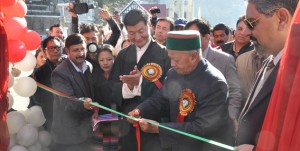On November 23, Shimla hosted the Himalayan Festival, a day-long event organised by the Himachal Tourism Department of the Government of India, and the Department of Home of the Central Tibetan Administration (CTA). The festival was aimed at promoting cultural understanding between the different peoples living in the Himalayan region, and Tibetan culture was highlighted throughout the day.
Tibetan stalls included an exhibition of the History of Tibet, screenings of films about the Dalai Lama, a sand mandala presentation by the Dorjee Drak Monastry in Shimla, Tibetan cuisines by Hotel Tibet, and folk songs and performances from the Tibetan Institute of Performing Arts.
During the festival, Sikyong Dr Lobsang Sangay, the Tibetan de facto Prime Minister, expressed his gratitude to the state of Himachal Pradesh for their support of the Tibetan People.
Addressing the audience, the Sikyong said, “We express our sincere and heartfelt gratitude to the government and people of Himachal Pradesh for their long-standing support to the Tibetan people.” He went on to say “His Holiness the Dalai Lama would be very happy for the joint effort of the government of Himachal Pradesh and CTA in organising the Himalayan Festival. It will send a message to the international community to visit the beautiful, green and peaceful state of Himachal Pradesh,”.
Chief Minister Virbhadra Singh, who inaugurated the festival, has been a long-term supporter of the Tibetan people. In his address he commented on the unique and beautiful religion and culture of the Tibetans, and said “It is our responsibility to take care of Tibetans living in exile and especially ensure that Tibetan children get good education. We hope and pray to god that Tibetans in exile will return to their homeland with dignity within my lifetime.” He also expressed his happiness that in the present age of modernisation, the people of the Himalayan regions had retained their cultures and traditions.
The aim of the festival, as highlighted by Health Kalon Dr Tsering Wangchul was to promote friendship and dialogue between the people living in the Himalayan region. Alongside Tibet, the cultures of Bhutan, Nepal, Sikkim, Ladakah and Kangra were also represented.





 Print
Print Email
Email